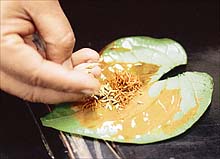Everyone in Bombay goes out for dinner. Then they go to Muchhad (pron. MOOCH-ard) Paanwala and eat paan, he has his own website, he sits all day in dhoti with a so-big moustache. Then the whole city goes bowling, or they play billiards. They’re all talking on their cell phones, from the age of eleven onward. Then they go to bed. Bombay is like that.
Yesterday I found the website of Muchhad Paanwala, which means Mustachioed Paan-maker. He is framed in this picture by a paan leaf. And he does indeed have a so-big moustache:

His father Shyam Charan Tiwari established the shop thirty years ago. The shop was named Muchhad because his father Shyam Charan Tiwari had mustache so big and long that it touched his ears. And now it's become a family tradition, all the four brothers have long mustache...
They believe and treat their customers like God. They keep personal and family like relations with their customers and believe in giving the best service to them. And all the ingredients that they use are very pure and genuine without any mixing...
Paan is a small packet made of a special leaf, wrapped around various ingredients – according to your taste -- and chewed. It is supposed to be good for digestion. The smell of gulkand, a rose jam which is an ingredient in sweet paan, is one of the most characteristic smells of India for me. The marks of paan-reddened spit on walls and footpaths are a common sight in the North.

The thirteenth century manual for dancers, Abhinayadarpanam, “Mirror of Gesture,” includes a graceful gesture for folding a paan leaf and offering it.
The accessories of paan can be beautiful: betel nut cutters,

and paandaans – the compartmented boxes in which paan is kept:

The amazing book Lucknow: The Last Phase of an Oriental Culture describes the ornate decadence of Lucknow just before its overthrow as a result of the 1857 Indian Mutiny. There are sections on Lucknow's diversions: poetry, story-telling, bird- and animal-fighting, pigeon-flying, kite-flying, music, dance, food, forms of headwear... and the eating of paan.
About the paandaan the author writes:
... In the boxes are two metal cups to contain kathha and lime, and three smaller, equal-sized receptacles for cut nuts of various kinds. All of these are arranged in a circle, in the middle of which is another small container to hold cardamoms or cloves... There are tiny spoons for the kathha and lime... Placed over all these containers is a large tray... in which raw betel leaves are placed, wrapped in a damp cloth....
The size [of the paandaan] began to increase until it came to weigh as much as twenty to forty pounds. At the same time it became necessary for ladies to take it with them wherever they went. Just as ‘the larger the turban, the greater the learning,’ so the larger the betel box, the greater was the status and grandeur of the lady. Eventually the betel box took up all the space in the palanquin and there was no room for the lady...
When we buy paan nowadays, we either take it from the hands of the paanwala directly, or have it wrapped in leaves or aluminum foil. That way, there's still plenty of room in the palanquin.
